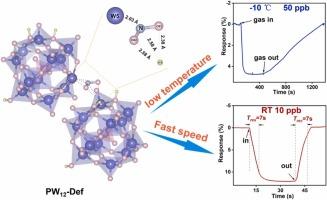Synergistic effect of protonation and oxygen vacancies in polyoxometalates for ppb-level NO2 detection at subzero temperatures
IF 3.7
1区 化学
Q1 CHEMISTRY, ANALYTICAL
引用次数: 0
Abstract
Accurate detection of nitrogen dioxide (NO2) at low concentrations and sub-zero temperatures is essential for environmental monitoring and industrial safety, particularly in cold regions where conventional sensors often fail due to poor sensitivity and slow response. Here, we report a defect-engineered phosphotungstic acid-based sensor that enables ultrasensitive NO2 detection with a limit of detection down to 0.17 ppb, rapid response/recovery times within 7/9 s, and robust operation even at −10 °C. This high-performance stems from a synergistic interaction between exposed Brønsted acid protons and thermally induced oxygen vacancies, which jointly facilitate NO2 chemisorption and redox activation. In-situ infrared spectroscopy reveals a dynamic conversion of NO2 to NO2- and NO3- on the sensor surface, corroborated by density functional theory (DFT) calculations showing enhanced adsorption energy and substantial charge transfer. Integrating this sensor into a smart NO2-responsive ventilation system enables real-time air quality regulation, demonstrating its practical utility in intelligent environmental control. Our findings present a viable route for next-generation gas sensors operable in harsh, low-temperature environments.

低温下多金属氧酸盐质子化和氧空位对ppb级NO2检测的协同效应
在低浓度和零度以下温度下准确检测二氧化氮(NO2)对于环境监测和工业安全至关重要,特别是在传统传感器由于灵敏度差和响应缓慢而经常失效的寒冷地区。在这里,我们报告了一种缺陷工程磷钨酸传感器,该传感器能够实现超灵敏的NO2检测,检测限低至0.17 ppb,快速响应/恢复时间在7/9秒内,即使在-10 °C下也能稳定运行。这种高性能源于暴露的Brønsted酸质子和热诱导的氧空位之间的协同相互作用,共同促进NO2的化学吸附和氧化还原活化。原位红外光谱揭示了传感器表面NO2向NO2-和NO3-的动态转化,密度泛函理论(DFT)计算证实了这一点,表明吸附能和大量电荷转移增强。将该传感器集成到智能no2响应通风系统中,实现实时空气质量调节,展示了其在智能环境控制中的实用性。我们的发现为在恶劣的低温环境中工作的下一代气体传感器提供了一条可行的途径。
本文章由计算机程序翻译,如有差异,请以英文原文为准。
求助全文
约1分钟内获得全文
求助全文
来源期刊

Sensors and Actuators B: Chemical
工程技术-电化学
CiteScore
14.60
自引率
11.90%
发文量
1776
审稿时长
3.2 months
期刊介绍:
Sensors & Actuators, B: Chemical is an international journal focused on the research and development of chemical transducers. It covers chemical sensors and biosensors, chemical actuators, and analytical microsystems. The journal is interdisciplinary, aiming to publish original works showcasing substantial advancements beyond the current state of the art in these fields, with practical applicability to solving meaningful analytical problems. Review articles are accepted by invitation from an Editor of the journal.
 求助内容:
求助内容: 应助结果提醒方式:
应助结果提醒方式:


